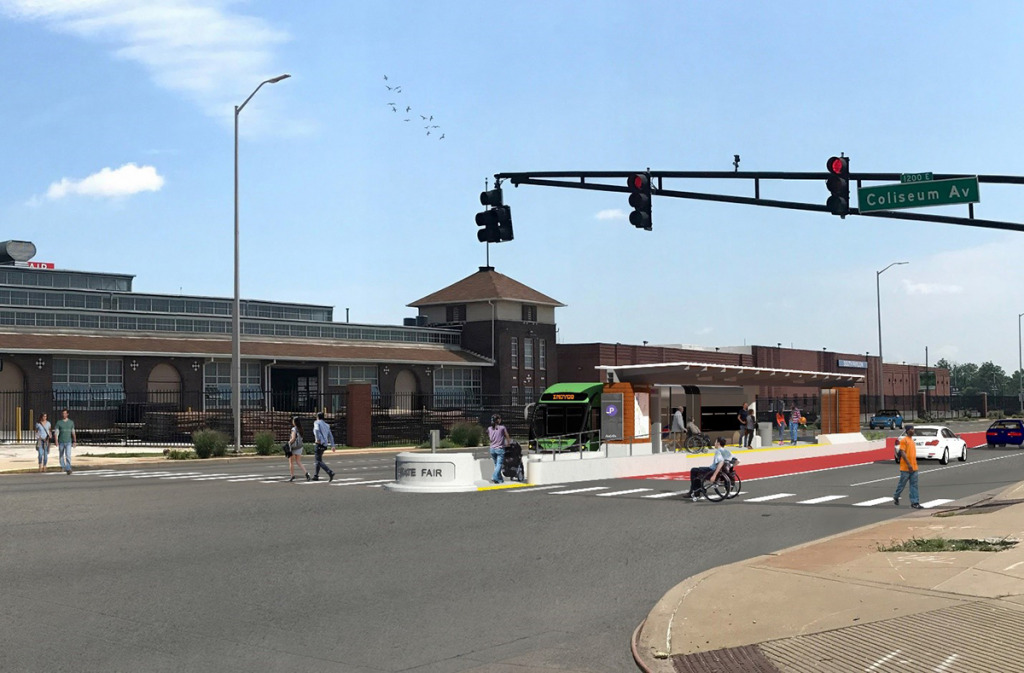Subscriber Benefit
As a subscriber you can listen to articles at work, in the car, or while you work out. Subscribe NowIndianapolis is moving ahead with the next two legs of its massive bus rapid transit project, after a messy state legislative session and pandemic-related problems threw a wrench in the timeline.
The Indianapolis Public Transportation Corp., better known as IndyGo, plans to spend $42 million on up to 30 new 60-foot battery electric buses from BYD. That’s the same manufacturer that produced the buses purchased for the Red Line, even though those buses failed to meet the contractually specified battery range, requiring BYD to spend millions on en route charging infrastructure and equipment retrofits. In fact, IndyGo withheld payment for those buses, saying it would pay when the buses met expectations.

The 15.2-mile Purple Line from downtown to Lawrence, which will include a stop at the Indiana State Fairgrounds, might be operating by 2024. (Rendering courtesy of IndyGo)That purchase is part of a laundry list of priority projects totaling $100 million. IndyGo hopes to take out $65 million in bonds to put toward it all, pending City-County Council approval, and plug the gap with cash from its own reserves or federal grants.
For IndyGo and its supporters, that’s simply the price to operate a public service. But not everyone’s convinced bonds are the way to go.
The Red Line, IndyGo’s first bus rapid transit line, celebrated its second year of operations this September. Now, the agency is moving ahead with plans for two sister lines: the Purple, extending 15.2 miles from downtown to Lawrence, and the Blue, running 24 miles from the airport to Cumberland.
But there have been delays.
IndyGo says the 2021 legislative session and the pandemic have complicated its timeline, according to IndyGo board documents.
State Sen. Aaron Freeman led two unsuccessful efforts earlier this year to punish IndyGo if it didn’t meet private fundraising requirements for public transportation projects, temporarily creating some uncertainty.

Supply-chain and other pandemic-related problems, meanwhile, pushed Purple Line construction to the first quarter of 2022 and briefly put work for the Blue Line on hold.
The agency now plans to award construction contracts for the Purple Line in December, according to spokeswoman Carrie Black. Construction is scheduled to begin early next year and end in 2024, with operations beginning that year, documents show.
Half of the money for the $162 million project is coming from the Federal Transit Administration’s Small Starts Capital Investment Grant program. IndyGo announced it landed the grant in August.
Back to BYD
To gear up for the Purple Line, IndyGo plans to order 28, 60-foot battery electric buses this year, with the option to order up to 30, according to Chief Financial Officer Bart Brown. The buses typically take 18 months to arrive after ordering, Brown told City-County councilors at a Municipal Corporations Committee meeting in October.

The price tag? About $42 million.
That’s under a five-year contract IndyGo awarded in 2017 to manufacturer BYD, which stands for Build Your Dreams. BYD is China-based but has a North American subsidiary headquartered in California and a handful of “service hubs.” One is in Indianapolis.
BYD also manufactured the Red Line buses, which, as of October, IndyGo had not paid for. The agency says problems reaching contractually specified mileage ranges for the buses are to blame.
“We have not paid BYD a dime for these buses, and we will not pay BYD a dime until we are confident that they will get out of these buses what we were promised and what we expected to get out of them,” Black told WRTV-TV Channel 6 last month. Black declined interview requests from IBJ.
The buses’ ranges fell short of the 275 miles required per charge, IBJ reported in March 2019. IndyGo test results released that month showed that drivers couldn’t top 256 miles, and that, on the coldest days, couldn’t crack 200.
But IndyGo is tapping BYD again for its next major bus order.
For one thing, the manufacturer agreed to keep its old per-bus base price locked in, said Paul Williams, senior director of facilities and preventative maintenance, at the IndyGo board’s October meeting.
And, everything else is tailor-made to BYD’s product. That matters more when the Red and Purple Lines overlap for part of their routes—buses for both lines will need to work with 15-inch platform heights, according to the board documents—and when BYD has paid for en route charging to make up for the range shortfalls.
Priority list
But before IndyGo can add buses, it needs somewhere to put them.
“Right now, today, we are full,” Brown, the CFO, told councilors. “One more bus that we buy that is extra, that’s not a replacement, we don’t have room for. So it’s paramount that we build a new facility.”
The new bus garage could cost $33.4 million, though Brown described that cost as a “conservative figure” and noted IndyGo was hoping to find better pricing. The facility would act as bus storage, but also as a full-service maintenance hub.
IndyGo’s $100 million project list also includes $4.5 million for a storage facility for its Open Door vehicles, which serve residents with disabilities.
If the agency can’t fill the funding gap, these will be at the front of the line.
“We’ll have to take a look at this list and say, ‘What gets funded first?’ And I’ll tell you what gets funded first: the facilities and the buses,” Brown said.
But the agency also hopes to outfit its fleet and facilities with air filtration and UV-C lighting to kill airborne pathogens ($2.9 million), plus update its dispatch system ($10 million) and lower the pavement at a Rural Street underpass ($6.6 million). Right now, buses can’t fit underneath it, forcing them to take a 1.5-mile detour and keeping routes at 30-minute frequency. The goal is 15 minutes.
“If we go to 15-minute intervals and we have to continue taking this detour, it’s going to cost us an extra $750,000 a year,” Brown said of the project. “… Over 20-25 years, we will recoup that, and shave off time.”
Transit spending
Some are skeptical that it’s all money worth spending, or that IndyGo can handle the debt load.
Republican Councilor Josh Bain urged spending on public safety and infrastructure, prompting CEO Inez Evans to note that more than half the Purple Line’s $168 million price tag is earmarked for infrastructure improvements.
The changes, which will take up a lane along much of 38th Street, are also expected to slow or divert the traffic that often blows through speed limits and red lights.
“We are a component of public safety,” Evans said.

Councilor Michael-Paul Hart, also a Republican, said he didn’t think the $65 million loan was responsible spending.
IndyGo has two outstanding bonds with nearly $40 million left, according to Angie Steeno, managing director at Crowe, which provides auditing and consulting services. One bond reaches maturity in 2028, and the other, issued this May, will mature in 2033, she said.
And after this year’s bond issuance, IndyGo plans to ask for an additional $65 million in bonds in 2023 to fund the Blue Line.
“As long as we don’t have to buy any more facilities and we hold the number of buses down, we will be able to present balanced budgets to the council,” Brown told Hart.
“That gives me a lot of concern,” Hart replied. “There’s a few ‘what-ifs’ in that situation.”
Hart added later in the meeting, “Where I want to make sure that we are very clear is, that if you fail … that you have to come back to this council and we have to take money away from other things.”
The committee gave IndyGo’s plan a preliminary OK, with members voting 4-2 along party lines. The full City-County Council will consider the bonds at its Dec. 6 meeting. If approved, the bonds would be priced and sold by the second quarter of 2022, or even sooner, according to Brown.
If all goes to plan, all three bus rapid transit routes will be operational within five years, minus an extension of the Red Line that’s been postponed indefinitely.
IndyGo expects designs for the Blue Line along Washington Street to be done in summer 2023, with construction beginning in 2024 and service starting in 2026, according to the board’s October documents.
Though the pandemic has dealt blows to the agency’s procurement efforts and construction costs, it’s also cut ridership. The Red Line has carried 629,000 passengers overall this year, as of September, versus 719,000 by that point last year, according to the October packet.
But long term, IndyGo says, it’ll work.
Already, monthly ridership is trending slightly higher. The Red Line served nearly 76,000 people in September, up from 73,000 last September, and IndyGo expects the numbers to bounce back late next year, according to its 2022 budget.
“We can’t predict the future, but when we build the [bus rapid transit], all our projections—and they’re solid projections—do estimate that we will recover, and add passengers,” Brown said.•
Please enable JavaScript to view this content.

“We can’t predict the future…” Actually, Mr. Brown, we predict the future all the time. Your next section talks about projections about future use. That’s a PREDICTION.
76,000 riders in a month is 208 riders a day on the Red Line. That seems to be a pathetic performance given how much we’ve spent on the Red Line and the congestion caused by taking travel lanes out of use for dedicated Red Line buses. To say the performance of the Red Line has been underwhelming is an understatement. Most of the very large Red Line buses usually have just a handful of passengers riding them. The “Build it and They Will Come” theory of mass transit has never worked anyplace so it’s not surprising it hasn’t worked in Indianapolis.
The need for large heavy buses to transport throngs of passengers to their jobs and shopping malls has long past. Many people work from home. People shop online. Instead of building a mass transit system to meet the needs of the future, city officials simply assumed future transportation needs would resemble those of the past. They guessed wrong. So what are city officials doing? Instead of doing some honest re-evaluation and making adjustments, they’re doubling down on their mistake by expanding a failed and highly expensive rapid bus system. Brilliant.
Sorry for the really bad math. Not sure how I screwed up the calculation. Anyway, 76,000 divided by 30 is 2,533 a day. Still most of the buses are operating at only a fraction of capacity. There is no reason for those big heavy buses when much smaller buses would suffice.
Mass transit is a wise investment for the future of Indianapolis. Improving it is long overdue. Indy is routinely passed over from outside business investment because of our ridiculously poor transit infrastructure. Transit is a major component of “quality of life” metrics, an area that Indy falls far behind other cities in. We will never attract the level of talent or businesses we want without a proper public transportation system. If you have ever been to another
John H, can you please cite any business that has not located here because of “our ridiculously poor transit infrastructure”
Rhea. Amazon H2, for one
at the end of the day it is still just a bus system – nothing rapid about it. This system actually takes out a bunch of stops and hurts the people that really use it so not really improving anything – would have been cheaper to add more buses and make the current stops more user friendly. the money would have been better spent on infrastructure for a driverless car/ride sharing system that is not that far from reality. but hey let’s face it, it’s all politics. Oh – and why are we buying more buses from the same company when the buses we have now are supposedly so bad??
Bryan, you’ve got to be particularly dillusional to believe Indy was ever a true contender. Sure, they made the final cut of 20 on paper, but that was never more than a successful attempt to get incredibly valuable information from as many cities as possible.
Bad math = bad thinking.
Smaller lighter buses? What’s the perceived advantage?
There is none. More than 70% of operating costs are attributable to operator wages and maintenance. Now, maintenance – typically smaller buses incur higher maintenance costs and must be replaced more often. Also, when higher demand is needed the smaller buses are not sufficient. A “handful’ is not data, it is perception. Buses in no city are full from the beginning of the route through the end. Capacity utilization varies throughout the day and by route segments as riders board and alight. Bear in mind the route restructuring to a more grid-like pattern where riders are not required to make extensive out of direction trip to a single transfer point in downtown. Furthermore, buses must be ADA compatible and must accommodate individuals and equipment efficiently — this is not achieved with small buses.
Highly expensive is subjective. The cost of the proposed BRT system is less than the cost of two freeway interchanges, such as the 65/70 North Split or the 465/70 east interchanges which has been reconstructed several times at significant cost.
Cost. Question is “highly expensive rapid bus system” compared to what? Compared to the $1.4 billion 20-mile starter light rail line in Phoenix ? Compared to the $900 million 8-mile rail extension to Munster IN? What about the Connect Austin bus and rail plan for $7.1 billion. Or, compared to the $175 million 15-mile Division St BRT in Portland OR.
Indygo BRT cost for the Red, Purple and Blue lines is: $471 million total, but local cost share is $219 million, for 51 miles of BRT. The Indygo plan is relatively modest cost for miles provided compared to other cities.
Some do have the option to work at home. Many of the riders who use Indygo daily do not and will not. Buses are not empty and ridership continues to trend upward. If so many indeed are working from home and will continue to do so, then traffic volumes and demand will significantly decrease; therefore, the two lanes dedicated to the Red Line along Meridian between 18th and 38th Street will not impact the ever decreasing traffic. If one reviews documentation of traffic analysis in the environmental reports and drives Meridian Street in the noted segment daily, it is clear that the Red Line has not caused traffic congestion. If one prefers a perceptually fast trip in this corridor, Illinois Street and Delaware offer convenient and efficient alternatives northbound; Capitol and Central offer southbound options. Now from the historical perspective, the travel time along Meridian was significantly slower 20 years ago (no BRT) than today.
Many guessed cities would be dead after the 1918 pandemic. That did not occur.
Indygo has reevaluated and identified changes. But BRT is still a key element in three corridors — those with the heaviest ridership. Signal timing and optimization options have been noted. Other changes for route structure, frequency, and connection are in response to comment received from the public, particularly riders who use the system daily. An extension to the north is no longer anticipated. But to better improve connectivity and access throughout the service district (Marion County) partnership with providers such as Lyft and Uber would serve as an extension of transit in areas where fixed route service would not be cost-effective.
In regard to future planning with transit, Indygo and Indianapolis is in great company with many growing and attractive cities such as Austin TX, Portland OR, Phoenix AZ and Salt Lake City UT — all continue to improve their transit which includes bus and rail. Granted, those cities are growing faster than Indianapolis but people in those places also work from home and shop online, but many in those low density, spread out cities also use transit. In consideration of nearby cities, Indianapolis is finally catching up to peer cities such as Louisville KY, Columbus OH, and Grand Rapids MI. Indygo implements bus improvements on three (just three) corridors, improves service frequency on the busiest routes, and links to ANCs — this is positive plan of action and modest in cost compared to other cities. To do nothing is not the answer.
I love using the Red Line!! In just a few short years, the combined BRT will be a shining beacon for the city
Spot on!
I doubt it will ever be a beacon for the City.
Critics of the BRT are not users of mass transit, as is obvious by their observations that busses are mostly empty. While that may be true at the terminus of routes, as the busses get closer to Downtown they fill up with riders. The city’s recent change in zoning near BRT stations to allow “by right” multi-use developments of increased heights and density will also provide a growing stream of riders in the future. The success of IndyGo’s plans depends on having an expanding network of both regular and BRT routes that feed off each other. To judge such plans a failure is both premature and foolish.
Mass transit is a wise investment for the future of Indianapolis. Improving it is long overdue. Indy is routinely passed over from outside business investment because of our ridiculously poor transit infrastructure. Transit is a major component of “quality of life” metrics, an area that Indy falls far behind other cities in. We will never attract the level of talent or businesses we want without a proper public transportation system. If you have ever been to another city, it is patently obvious.
The main issue with the Red Line was that it was supposed to run North to Carmel and provide transportation to the offices, hotels and shops on Pennsylvania St. The second transit. Pre Covid businesses on 96th and Collage and North would have loved bus service for their employees. Could have split and had a Gieco, heart hospital shuttle, etc. instead nothing due to NIMBY.
Do you ever find it ironic how some can exalt the virtues and justness of the public participation but resort to name-calling when they don’t get their way?
Perhaps the problem is IndyGo and the MPO didn’t do the leg work during the planning program to see if an extension into Carmel was something Carmel would support.
The legwork was done. This is documented in the Connect Indy and other reports completed by the MPO. The follow up plan was to assess function after the system started than consider extensions. The case is similar for Johnson County which did complete a transit plan and is considering options. However, demographics and history are different for Johnson County.
Also bear in mind the State Legislature dictates regarding transit and the facts for local (read: county). Each county in the Indianapolis region can decide to join. So far, only Marion County is in; the historical service to Johnson County notwithstanding. Unlike many cities where transit is provided to the region, Indygo is essentially limited to Marion County system and adjacent counties have no transit to (even) allow transfers.
Perhaps reverse commute or directional (alight only/board only) could be provided into Hamilton County, with county permission of course, to allow Marion County residents access to jobs and markets there. In this case all costs would be borne by Indygo/Marion County residents and the service would not allow intra-Hamilton county trips. Or, Uber and Lyft could be used as a first-mile/last-mile feeder/distributor to Indygo service at fixed transfer point that could be established in the College Park, Nora, and Castleton areas.
Actually, CIRTA should coordinate any external trips as has been done with the Whitestown shuttle.
IndyGo desperately needs audited.
Conducted by the Federal Transit Administration for the federally funded projects. Why does Indygo need to be audited. What is the concern or fear?